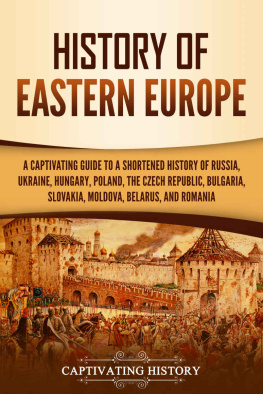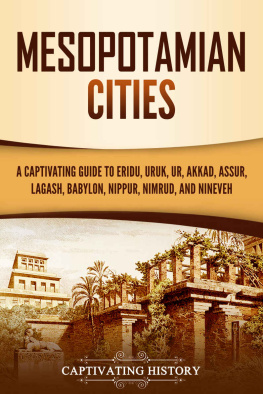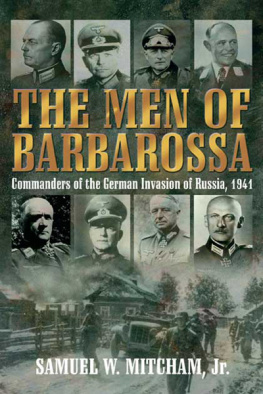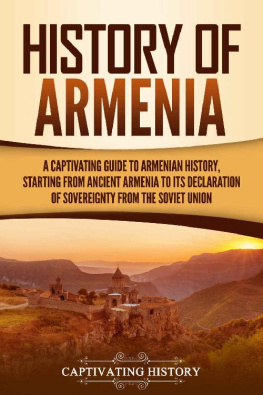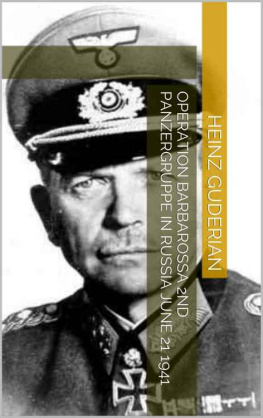Captivating History - Operation Barbarossa: A Captivating Guide to the Opening Months of the War between Hitler and the Soviet Union in 1941–45
Here you can read online Captivating History - Operation Barbarossa: A Captivating Guide to the Opening Months of the War between Hitler and the Soviet Union in 1941–45 full text of the book (entire story) in english for free. Download pdf and epub, get meaning, cover and reviews about this ebook. year: 2020, genre: History. Description of the work, (preface) as well as reviews are available. Best literature library LitArk.com created for fans of good reading and offers a wide selection of genres:
Romance novel
Science fiction
Adventure
Detective
Science
History
Home and family
Prose
Art
Politics
Computer
Non-fiction
Religion
Business
Children
Humor
Choose a favorite category and find really read worthwhile books. Enjoy immersion in the world of imagination, feel the emotions of the characters or learn something new for yourself, make an fascinating discovery.

- Book:Operation Barbarossa: A Captivating Guide to the Opening Months of the War between Hitler and the Soviet Union in 1941–45
- Author:
- Genre:
- Year:2020
- Rating:3 / 5
- Favourites:Add to favourites
- Your mark:
- 60
- 1
- 2
- 3
- 4
- 5
Operation Barbarossa: A Captivating Guide to the Opening Months of the War between Hitler and the Soviet Union in 1941–45: summary, description and annotation
We offer to read an annotation, description, summary or preface (depends on what the author of the book "Operation Barbarossa: A Captivating Guide to the Opening Months of the War between Hitler and the Soviet Union in 1941–45" wrote himself). If you haven't found the necessary information about the book — write in the comments, we will try to find it.
Captivating History: author's other books
Who wrote Operation Barbarossa: A Captivating Guide to the Opening Months of the War between Hitler and the Soviet Union in 1941–45? Find out the surname, the name of the author of the book and a list of all author's works by series.
Operation Barbarossa: A Captivating Guide to the Opening Months of the War between Hitler and the Soviet Union in 1941–45 — read online for free the complete book (whole text) full work
Below is the text of the book, divided by pages. System saving the place of the last page read, allows you to conveniently read the book "Operation Barbarossa: A Captivating Guide to the Opening Months of the War between Hitler and the Soviet Union in 1941–45" online for free, without having to search again every time where you left off. Put a bookmark, and you can go to the page where you finished reading at any time.
Font size:
Interval:
Bookmark:
All Rights Reserved. No part of this book may be reproduced in any form without permission in writing from the author. Reviewers may quote brief passages in reviews.
Disclaimer: No part of this publication may be reproduced or transmitted in any form or by any means, mechanical or electronic, including photocopying or recording, or by any information storage and retrieval system, or transmitted by email without permission in writing from the publisher.
While all attempts have been made to verify the information provided in this publication, neither the author nor the publisher assumes any responsibility for errors, omissions or contrary interpretations of the subject matter herein.
This book is for entertainment purposes only. The views expressed are those of the author alone, and should not be taken as expert instruction or commands. The reader is responsible for his or her own actions.
Adherence to all applicable laws and regulations, including international, federal, state and local laws governing professional licensing, business practices, advertising and all other aspects of doing business in the US, Canada, UK or any other jurisdiction is the sole responsibility of the purchaser or reader.
Neither the author nor the publisher assumes any responsibility or liability whatsoever on the behalf of the purchaser or reader of these materials. Any perceived slight of any individual or organization is purely unintentional.
Hi History Lovers!
My name is Matt Clayton, and Im the creator of Captivating History. First off, I want to THANK YOU for reading our books in the Captivating History series. As an avid reader of History myself, I aim to produce books that will hold you captive.
Now you have a chance to join our exclusive history list so you can get the ebook below for free as well as discounts and a potential to get more history books for free! Simply click the link below to join.
P.S. If you join now, you will also receive a free Mythology book. Remember that its 100% free to join the list.

Click here to access your bonus
Also, make sure to follow us on:
Twitter: @Captivhistory
Facebook: Captivating History: @captivatinghistory
Introduction
On June 22 nd , 1941, Nazi Germany launched Operation Barbarossa, the invasion of the Soviet Union. In the time since the end of the war, the world has become familiar with the number of deaths sustained by the Soviet Union (also known as the USSR) during the conflicttwenty-million. And thats likely low, given the size of the country, census taking at the time, and the damage done to the bureaucracy of the country. Think about it: twenty million people. That is a figure that is almost impossible to wrap ones mind around. Nearly every family in the nation lost someone. The most celebrated and biggest holiday in the Soviet Union, now the nations of Russia, Ukraine, and Belarus (the former Soviet republics that were most affected by the war) is May 8 th , Victory Day, which celebrates the USSRs victory over Nazi Germany in what was called the Great Patriotic War, honoring the heroes and remembering those lost.
Geoffrey Roberts, a British historian of the Soviet Union in World War II, in his work, Stalins Wars: From World War to Cold War, 1939-1953 (2006), attempted to tally the losses in terms of infrastructure, making them all the starker. During the Nazi invasion and occupation, the Soviet Union lost an estimated:
70,000 Soviet cities, towns, and villages
32,000 factories
6,000 hospitals
82,000 schools
43,000 libraries
Historian Jacob Pauwels and others found that the USSR did not regain its pre-war economic levels until the early/mid-1960s.
Adolf Hitler invaded the Soviet Union with over three million men. The Soviets had just under that number in the western section of their country to meet them, as well as millions more elsewhere, which was something Hitler did not count on and grossly underestimated.
The struggle between the Soviet Union and Nazi Germany was one of the largest and deadliest conflicts of all time, a war of elimination between totalitarian nations led by two of the most ruthless leaders in the history of the world.
In Mein Kampf ( My Struggle ), Hitlers political testament and autobiography (in quotes because much of what is written about his life was exaggerated or made up, especially his claim of poverty; his father was a big fish in a small town with a maid, a pension, a uniform, and respect), the future dictator of Germany repeatedly stated his belief that it was the destiny of the German nation to expand to the east.
Germany, after World War I and even today, is roughly the size of the American states of Washington and Oregon together. The population of those two states combined is about twelve million people. The population of Germany at the time of World War II was seventy million (today, its eighty million). Hitler was not the only German-speaking person to hold the belief that Germany needed to secure Lebensraum (living space) in order to thrive and survive in a crowded Europe with enemies on all sides. Indeed, along with the vicious anti-Semitism included within Mein Kampf , the idea of Lebensraum is the most mentioned and elaborated upon.
In the years before the war, many of those in other nations who had read Hitlers book and who saw him clearly for what he was repeatedly told anyone who was willing to listen that Hitler meant to start a war of expansion in the east, which might evolve into another world war. Chief among these people was one of the leading political figures of Great Britain and its future leader, Winston Churchill.
In the years before the previous world war, many Europeans (especially those in the larger and more powerful nations of France, the United Kingdom, Austria-Hungary, Germany, and Russia) held the belief that their nations needed to gain or hold onto territories and colonial empires in order to thrive. Though much of this late 19 th -century imperialism was supported by an undercurrent of racial superiority, its aims were economic gains and the power and prestige that came with a large empire.
However, Germany, prior to World War I, had a sizable minority of politicians, writers, philosophers, and journalists who were beginning to gravitate to a vision of Germany and Germanic peoples (which included the British, Scandinavians, Dutch, etc.) as a superior race, noting both their economic and military power along with their outsized cultural influence. This Germanic superiority extended over the other peoples of Europe, especially to the Slavic nations of the east.
Hitler, along with many Germans, Austrians, and other Europeans, were not alone in holding these beliefs; they existed in the United States and Canada as well. In the years between World War I and World War II, these ideas combined with new advances in science to bring forth the new science of eugenics, the idea that it would be possible to medically weed out hereditary and other infirmities such as intellectual disabilities, epilepsy, alcoholism, etc. On its fringes, the field of eugenics included educated medical professionals and philosophers who believed that it would be possible to breed out such infirmities and encourage the procreation of individuals who were believed to be smarter, better-looking, more fit, and healthy. Once it was combined with the idea that Northern European Germanic peoples were superior, eugenics began to enter a new and dangerous phase by the time Hitler came to power.
Font size:
Interval:
Bookmark:
Similar books «Operation Barbarossa: A Captivating Guide to the Opening Months of the War between Hitler and the Soviet Union in 1941–45»
Look at similar books to Operation Barbarossa: A Captivating Guide to the Opening Months of the War between Hitler and the Soviet Union in 1941–45. We have selected literature similar in name and meaning in the hope of providing readers with more options to find new, interesting, not yet read works.
Discussion, reviews of the book Operation Barbarossa: A Captivating Guide to the Opening Months of the War between Hitler and the Soviet Union in 1941–45 and just readers' own opinions. Leave your comments, write what you think about the work, its meaning or the main characters. Specify what exactly you liked and what you didn't like, and why you think so.


